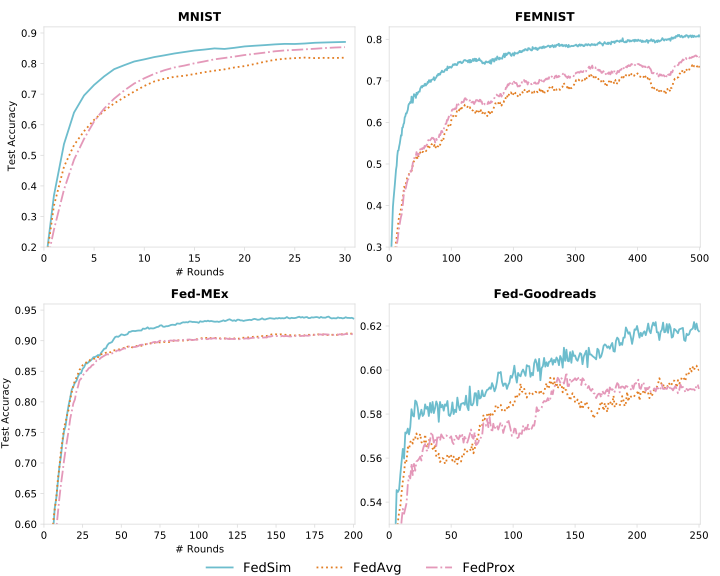Similarity Guided Model Aggregation for Federated Learning
This work is published at the Neurocomputing Journal FedSim: Similarity guided model aggregation for Federated Learning
Bibtext
@article{palihawadana2021fedsim,
title={FedSim: Similarity guided model aggregation for Federated Learning},
author={Palihawadana, Chamath and Wiratunga, Nirmalie and Wijekoon, Anjana and Kalutarage, Harsha},
journal={Neurocomputing},
year={2021},
publisher={Elsevier}
}
bash run_fedsim.sh DATASET_NAME DROP_PERC NUM_CLUSTERS NUM_CLIENTS Run_Name
bash run_fedsim.sh mnist 0 9 20 mnist_runFedSim algorithm implementation is available in flearn/trainers/fedsim.py.
The experiments performed on all the datasets were carried out with 35 random seeds (from 0 to 34 incremented by 1) to empirically demonstrate the significance. Repetition of the same experiment with different random seeds helps to reduce the sampling error of our experiments.
For a single dataset, run rounds of FedSim, FedAvg and FedProx where each run will generate a single folder in the logs folder, as a reference we have added a sample log folder with the results in logs/sample/
Used hyper parameters for the experiments are presented in Table 2.
Once the experiments are completed, create the summary log files with the 3 methods as in results/ folder. We have added our results in here which can help to refer and use FedSim.
-
Figure 3 - Results on real datasets -
plot_fedsim_main.py -
Figure 5 - Accuracy improvements of FedSim -
plot_fedsim_improvements.py -
Figure 6 - Results on synthetic datasets -
plot_fedsim_main.pychange line #123 toif(True) -
Figure 7 - Results on other learning models -
plot_fedsim_other.py
We have adapted the experiment setup from FedProx and Leaf Benchmark work. Thanks for the support by Tian Li.
For all datasets, see the README files in separate data/$dataset folders for instructions on preprocessing and/or sampling data.
For further clarifications follow the guides on FedProx and Leaf
The two datasets produced with this work is published with the generation source code.
pip3 install -r requirements.txt
bash run_fedsim.sh DATASET_NAME 0 NUM_CLUSTERS NUM_CLIENTS Run_Name
bash run_fedavg.sh mnist 0 9 20 mnist_runor direcly use the python command
python3 -u main.py --dataset='goodreads' --optimizer='fedsim' --learning_rate=0.0001
--num_rounds=250 --clients_per_round=20 --eval_every=1 --batch_size=10 --num_epochs=10
--model='rnn' --drop_percent=0 --num_groups=11 --ex_name=goodreads_rnn_0 --seed=0When running on GPU specify the id and then run the experiments
export CUDA_VISIBLE_DEVICES=GPU_ID
Figure 3: Comparison of performances over communication rounds with real-world datasets
Figure 5: Accuracy improvements of FedSim compared to FedAvg and FedProx of experiments in Figure 3. Values below zero indicate negative performance against a baseline and grey vertical lines denote areas of no statistical significance

